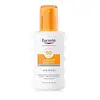What's inside
What's inside
 Key Ingredients
Key Ingredients

 Benefits
Benefits

 Concerns
Concerns

 Ingredients Side-by-side
Ingredients Side-by-side

Acrylates/C10-30 Alkyl Acrylate Crosspolymer
Emulsion StabilisingAlcohol Denat.
AntimicrobialWater
Skin ConditioningBis-Ethylhexyloxyphenol Methoxyphenyl Triazine
Skin ConditioningButyl Methoxydibenzoylmethane
UV AbsorberCellulose Gum
Emulsion StabilisingCopernicia Cerifera Cera
EmollientDibutyl Adipate
EmollientEthylhexyl Salicylate
UV AbsorberEthylhexyl Triazone
UV AbsorberEthylhexylglycerin
Skin ConditioningGlycerin
HumectantGlycyrrhetinic Acid
Skin ConditioningGlycyrrhiza Inflata Root Extract
Skin ConditioningHomosalate
Skin ConditioningHydrogenated Polyisobutene
EmollientMicrocrystalline Cellulose
AbsorbentPhenoxyethanol
PreservativePhenylbenzimidazole Sulfonic Acid
UV AbsorberSodium Hydroxide
BufferingSodium Stearoyl Glutamate
CleansingSucrose Polystearate
EmollientTetrasodium Iminodisuccinate
Trisodium EDTA
Vp/Hexadecene Copolymer
Xanthan Gum
EmulsifyingAcrylates/C10-30 Alkyl Acrylate Crosspolymer, Alcohol Denat., Water, Bis-Ethylhexyloxyphenol Methoxyphenyl Triazine, Butyl Methoxydibenzoylmethane, Cellulose Gum, Copernicia Cerifera Cera, Dibutyl Adipate, Ethylhexyl Salicylate, Ethylhexyl Triazone, Ethylhexylglycerin, Glycerin, Glycyrrhetinic Acid, Glycyrrhiza Inflata Root Extract, Homosalate, Hydrogenated Polyisobutene, Microcrystalline Cellulose, Phenoxyethanol, Phenylbenzimidazole Sulfonic Acid, Sodium Hydroxide, Sodium Stearoyl Glutamate, Sucrose Polystearate, Tetrasodium Iminodisuccinate, Trisodium EDTA, Vp/Hexadecene Copolymer, Xanthan Gum
Water
Skin ConditioningDibutyl Adipate
EmollientDiethylamino Hydroxybenzoyl Hexyl Benzoate
UV FilterDiisopropyl Sebacate
EmollientEthylhexyl Salicylate
UV AbsorberEthylhexyl Triazone
UV AbsorberPropanediol
SolventBis-Ethylhexyloxyphenol Methoxyphenyl Triazine
Skin ConditioningPhenylbenzimidazole Sulfonic Acid
UV AbsorberCetearyl Alcohol
EmollientPerlite
AbsorbentTriethanolamine
Buffering1,2-Hexanediol
Skin ConditioningPotassium Cetyl Phosphate
EmulsifyingPoly C10-30 Alkyl Acrylate
Emulsion StabilisingSilica
AbrasiveSodium Hyaluronate
HumectantBis-Ethylhexyl Hydroxydimethoxy Benzylmalonate
AntioxidantTocopheryl Acetate
AntioxidantCetyl Dimethicone
EmollientHydroxyacetophenone
AntioxidantXanthan Gum
EmulsifyingPolyacrylate Crosspolymer-6
Emulsion StabilisingCaesalpinia Spinosa Gum
Skin ConditioningPhenoxyethanol
PreservativeWater, Dibutyl Adipate, Diethylamino Hydroxybenzoyl Hexyl Benzoate, Diisopropyl Sebacate, Ethylhexyl Salicylate, Ethylhexyl Triazone, Propanediol, Bis-Ethylhexyloxyphenol Methoxyphenyl Triazine, Phenylbenzimidazole Sulfonic Acid, Cetearyl Alcohol, Perlite, Triethanolamine, 1,2-Hexanediol, Potassium Cetyl Phosphate, Poly C10-30 Alkyl Acrylate, Silica, Sodium Hyaluronate, Bis-Ethylhexyl Hydroxydimethoxy Benzylmalonate, Tocopheryl Acetate, Cetyl Dimethicone, Hydroxyacetophenone, Xanthan Gum, Polyacrylate Crosspolymer-6, Caesalpinia Spinosa Gum, Phenoxyethanol
Ingredients Explained
These ingredients are found in both products.
Ingredients higher up in an ingredient list are typically present in a larger amount.
You might know this ingredient as Tinosorb S or Bemotrizinol. It is a UV filter that covers both UVA and UVB rays.
This ingredient has two peak UV absorption peaks ( 310 and 340 nm) and is able to absorb both UV-A and UV-B rays. This ingredient works by preventing UV rays from reaching and damaging your skin.
On top of that - it is highly photostable and helps prevent the photodegration of other sunscreen ingredients such as avobenzone.
Tinosorb S is allowed in the EU, Australia, and Asia. It is close to being approved by the FDA and we'll hopefully get this ingredient in the U.S. by late 2025.
Fun fact: Tinosorb S is the most effective UV absorber at maximum concentration (measured by SPF) permitted in the EU.
This ingredient is oil-soluble, so your oil-cleansers will take this right off at night.
Learn more about Bis-Ethylhexyloxyphenol Methoxyphenyl TriazineDibutyl Adipate is an emollient and solvent. It is created from butyl alcohol and adipic acid.
As a solvent, Dibutyl Adipate helps mix and disperse ingredients evenly.
Dibutyl Adipate is soluble in water and organic solvents. It does not absorb UV rays.
Learn more about Dibutyl AdipateEthylhexyl Salicylate is an organic compound used to block UV rays. It primarily absorbs UVB rays but offers a small amount of UVA protection as well.
Commonly found in sunscreens, Ethylhexyl Salicylate is created from salicylic acid and 2-ethylhexanol. You might know salicylic acid as the effective acne fighter ingredient and BHA.
The ethylhexanol in this ingredient is a fatty alcohol and helps hydrate your skin, similar to oils. It is an emollient, which means it traps moisture into the skin.
According to manufacturers, Ethylhexyl Salicylate absorbs UV wavelength of 295-315 nm, with a peak absorption at 307-310 nm. UVA rays are linked to long term skin damage, such as hyperpigmentation. UVB rays emit more energy and are capable of damaging our DNA. UVB rays cause sunburn.
Learn more about Ethylhexyl SalicylateEthylhexyl Triazone is a modern chemical sunscreen that protects from UV-B radiation.
It is the most effective of existing UV-B filters, as it provides the highest level of photo-stable absorption. It protects from the entire UV-B range (280 to 320nm), with it's highest level of protection at 314nm.
Ethylhexyl Triazone is oil soluble, oderless and colorless, which mean it is able to be incorporated into a variety of different formulations.
It is not currently available within the United States due to slow changing FDA regulations. Outside of the US, it is used in formulations at concentrations up to 5%.
Learn more about Ethylhexyl TriazonePhenoxyethanol is a preservative that has germicide, antimicrobial, and aromatic properties. Studies show that phenoxyethanol can prevent microbial growth. By itself, it has a scent that is similar to that of a rose.
It's often used in formulations along with Caprylyl Glycol to preserve the shelf life of products.
This ingredient is more commonly known as Ensulizole, a chemical sunscreen ingredient.
Ensulizole mainly protects UV-B (290-340 nm) but offers a little UV-A (320-400 nm) protection. It is often paired with less photo-stable sunscreen ingredients due to its photo-stability.
Due to it being water-soluble, Ensulizole helps give sunscreens a light and non-oily texture.
Ensulizole is approved worldwide:
Learn more about Phenylbenzimidazole Sulfonic AcidWater. It's the most common cosmetic ingredient of all. You'll usually see it at the top of ingredient lists, meaning that it makes up the largest part of the product.
So why is it so popular? Water most often acts as a solvent - this means that it helps dissolve other ingredients into the formulation.
You'll also recognize water as that liquid we all need to stay alive. If you see this, drink a glass of water. Stay hydrated!
Learn more about WaterXanthan gum is used as a stabilizer and thickener within cosmetic products. It helps give products a sticky, thick feeling - preventing them from being too runny.
On the technical side of things, xanthan gum is a polysaccharide - a combination consisting of multiple sugar molecules bonded together.
Xanthan gum is a pretty common and great ingredient. It is a natural, non-toxic, non-irritating ingredient that is also commonly used in food products.
Learn more about Xanthan Gum